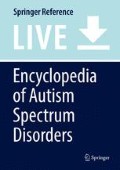References and Reading
Attwood, T. (1998). Asperger’s syndrome: A guide for parents and professionals. London: Jessica Kingsley Publishers.
Baron-Cohen, S. (1995). Mind blindness: An essay on autism and theory of mind. Cambridge, MA: The MIT Press.
Baron-Cohen, S. (2002). The extreme male brain theory of autism. Trends in Cognitive Sciences, 6(6), 248–254.
Boucher, J. (2003). Language development in autism. International Journal of Pediatric Otorhinilaryngology, 67S1, S159–S163.
Chown, N. (2015). Do researchers evaluate psychosocial interventions for autism from the perspective of the three dominant cognitive autism theories? Review Journal of Autism and Developmental Disorders, 2(3), 243–261.
Corbett, B. A., Constantine, L. J., Hendren, R., Rocke, D., & Ozonoff, S. (2009). Examining executive functioning in children with autism spectrum disorder, attention deficit hyperactivity disorder and typical development. Psychiatry Research, 166(2), 210–222.
Delis, D. C. (2012). Introduction: A history of executive functioning as a theoretical and clinical construct. In S. Goldstein, J. A. Naglieri, D. Princiotta, & T. M. Otero (Eds.), Handbook of executive functioning (pp. 3–12). New York: Springer. (2014).
Frith, U., & Happé, F. (1994). Autism: Beyond “theory of mind”. Cognition, 50(1), 115–132.
Frith, U., & Happé, F. (1999). Theory of mind and self-consciousness: What is it like to be autistic? Mind & Language, 14, 1–22.
Gallagher, S. (2008). Inference or interaction: Social cognition without precursors. Philosophical Explorations, 11(3), 163–174.
Happé, F., & Frith, U. (2006). The weak coherence account: Detail-focused cognitive style in autism spectrum disorders. Journal of Autism and Developmental Disorders, 36(1), 5–25.
Hutto, D. D. (2007). The narrative practice hypothesis: Origins and applications of folk psychology. In D. D. Hutto (Ed.), Narrative and understanding persons. Royal Institute of Philosophy Supplement, Cambridge, Cambridge University Press.
Klin, A., Jones, W., Schultz, R., & Volkmar, F. (2003). The enactive mind, or from actions to cognition: Lessons from autism. Philos Trans R Soc Lond B: Biol Sci, 358(1430), 345–360.
Macintosh, K. E., & Dissanayake, C. (2004). The similarities and differences between autistic disorder and Asperger’s disorder: A review of the empirical evidence. Journal of Child Psychology and Psychiatry, 45(3), 421–434.
McGeer, V. (2001). Psycho-practice, psycho-theory and the contrastive case of autism: How practices of mind become second-nature. Journal of Consciousness Studies, 8, 109–132.
Mottron, L., & Burack, J. A. (2001). Enhanced perceptual functioning in the development of autism. In J. A. Burack, T. Charman, N. Yirmiya, & P. R. Zelazo (Eds.), The development of autism: Perspectives from theory and research. Mahwah: Lawrence Erlbaum Associates Publishers.
Mottron, L., Dawson, M., Soulières, I., Hubert, B., & Burack, J. (2006). Enhanced perceptual functioning in autism: An update, and eight principles of autistic perception. Journal of Autism and Developmental Disorders, 36(1), 27–43.
Murray, D., Lesser, M., & Lawson, W. (2005). Attention, monotropism and the diagnostic criteria for autism. Autism, 9(2), 139–156.
Woodruff, G., & Premack, D. (1979). Intentional communication in the chimpanzee: The development of deception. Cognition, 7(4), 333–362.
Wootton, A. J. (2002). Interactional contrasts between typically developing children and those with autism, Asperger’s syndrome, and pragmatic impairment. Issues in Applied Linguistics, 13(2), 133–159.
Author information
Authors and Affiliations
Corresponding author
Editor information
Editors and Affiliations
Rights and permissions
Copyright information
© 2017 Springer Science+Business Media LLC
About this entry
Cite this entry
Chown, N., Beardon, L. (2017). Autism Theory. In: Volkmar, F. (eds) Encyclopedia of Autism Spectrum Disorders. Springer, New York, NY. https://doi.org/10.1007/978-1-4614-6435-8_102224-1
Download citation
DOI: https://doi.org/10.1007/978-1-4614-6435-8_102224-1
Received:
Accepted:
Published:
Publisher Name: Springer, New York, NY
Print ISBN: 978-1-4614-6435-8
Online ISBN: 978-1-4614-6435-8
eBook Packages: Springer Reference Behavioral Science and PsychologyReference Module Humanities and Social SciencesReference Module Business, Economics and Social Sciences

